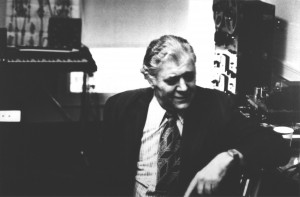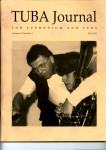 To many wind instrumentalists the name Arnold Jacobs is synonymous with the study of breathing. From contact with his students and his student’s students, many have become intrigued by strange devices, marveled at interesting exercises, and thrilled to unusual concepts. Suddenly colleague’s torsos are expanding to voluminous widths as they hear “breathe to expand,” just before they nuzzle their mouths into a breathing bag. Breathing tubes and open syllables abound as these disciples seek maximum suction with minimal friction. One is warned of various misuses of ones breathing apparatus, and told to become “tall and flabby.” One becomes acquainted with resting lung capacity and vacuum gauges only to wonder if perhaps the functional hasn’t overtaken the musical.
To many wind instrumentalists the name Arnold Jacobs is synonymous with the study of breathing. From contact with his students and his student’s students, many have become intrigued by strange devices, marveled at interesting exercises, and thrilled to unusual concepts. Suddenly colleague’s torsos are expanding to voluminous widths as they hear “breathe to expand,” just before they nuzzle their mouths into a breathing bag. Breathing tubes and open syllables abound as these disciples seek maximum suction with minimal friction. One is warned of various misuses of ones breathing apparatus, and told to become “tall and flabby.” One becomes acquainted with resting lung capacity and vacuum gauges only to wonder if perhaps the functional hasn’t overtaken the musical.
“Breathe to expand,” is a common rebuke to students who show all of the outward and visible signs of taking a breathe but, in truth, suck in very modest amounts of air. By protruding their stomachs and raising their chests, these students reverse the axiom and act as though they must first expand in order to breathe. Holding his nose shut and his mouth closed, Mr. Jacobs protrudes his stomach and expands his chest to make the point that these dramatic gesticulations can be accomplished without taking in any air. Explaining that stomach displacement is a product of inspiration (inhalation), he advocates focusing upon the amount of air moved.
With the stated aim of “maximum suction with minimal friction,” Mr. Jacobs helps his students to take in large quantities of air and release it as wind rather than pressure. Returning to his multi-sensory approach, he advocates that students breathe toward the lips, which can sense wind passing over them. A vacuum gauge directed at ones open mouth during the time of  inspiration, a breathing bag which expands with every exhalation, or a ping-pong ball held in a tube and suspended by constant wind movement in both directions, serve as visual aids to assist sensing the volume of air as wind. Holding one hand in front of ones mouth while exhaling provides a tactile sense for wind exhaling, while the sides of the mouth and the throat can join the lips in sensing incoming air. This information of sensation allows the body to regulate function while the performer focuses upon music.
inspiration, a breathing bag which expands with every exhalation, or a ping-pong ball held in a tube and suspended by constant wind movement in both directions, serve as visual aids to assist sensing the volume of air as wind. Holding one hand in front of ones mouth while exhaling provides a tactile sense for wind exhaling, while the sides of the mouth and the throat can join the lips in sensing incoming air. This information of sensation allows the body to regulate function while the performer focuses upon music.
While the above-mentioned options are ways of sensing air as freely flowing wind, a pressurized tension causing air stream is most easily sensed internally. To illustrate the distinction between the two, Mr. Jacobs has his students place an index finger at their lips, sealing them and then blow against it. When the finger is released, there is a light pop. This pressure in brass playing is similar to the pressure exerted I when coughing, blowing a particularly stiff balloon, or akin to the pressure in an inner tube. Wind as free flowing air is illustrated quite differently. Mr. Jacobs has students take in a normal breath and then allow air to escape from the lungs through the lips, sealing them only for a second, then remove the finger.
Pressurized air in brass playing is dangerous because any musculature used to regulate the air, and thus pressurize it, is more powerful than the musculature originating the air itself. Actively seal your lips, and then try to blow them apart. It is impossible. The same  is true of a closed throat. Similarly, a person’s chest and abdominal muscles are capable of supporting the weight of a one hundred pound person standing on them, while the lungs can generate approximately two to three pounds of pressure. Symptoms of playing with pressurized air are: delayed attacks (pressure takes time to overcome the biological valve that has been placed in its opposition, and the valve grows stronger with use, thus causing greater delays; a harsh tone quality (when the lips serve as a point of resistance rather than as a source of resonance); and excessive effort when playing (isometric tension as muscles resist pressurized air).
is true of a closed throat. Similarly, a person’s chest and abdominal muscles are capable of supporting the weight of a one hundred pound person standing on them, while the lungs can generate approximately two to three pounds of pressure. Symptoms of playing with pressurized air are: delayed attacks (pressure takes time to overcome the biological valve that has been placed in its opposition, and the valve grows stronger with use, thus causing greater delays; a harsh tone quality (when the lips serve as a point of resistance rather than as a source of resonance); and excessive effort when playing (isometric tension as muscles resist pressurized air).
The musculature of the respiratory system has at least three distinct functions. Students are often caught up in the process of one or another of the functions of these muscles, thus causing tension and confusion. In addition to breathing, these muscles are used to create internal pressure useful for childbirth, defecation, and the Valsalva maneuver (similar to the Heimlich maneuver). Finally, they are used for the purpose of stabilization, as one is constantly falling to the left and right, forward and backward, and being adjusted back to center by abdominal, intercostal, and back muscles. As brass players incorrectly focus upon and activate these muscles, tension and pressure adversely effect their tone production. To demonstrate the result of muscle tension upon tone quality, Mr. Jacobs might begin by having a student hold a long tone. As the student continues playing, Mr. Jacobs instructs him to tighten his biceps and triceps. This muscle tension typically has an immediate and adverse effect on the tone. By comparing this to muscle tension located elsewhere in the body, and particularly in the muscles used for respiration, Mr. Jacobs makes a case for a relaxed breathing mechanism.
The primary muscle of respiration is the diaphragm, and although the strap muscles are also capable of inspiration (clavicle breathing) for the purpose of wind instrument  performance they are relatively insignificant. From its inverted curve shape, just beneath the heart and lungs, the diaphragm flattens as it contacts, thus lowering air pressure in the lungs. This causes an inward rush of external air until pressure is equalized, and increases interthoracic pressure as the diaphragm displaces its contents outward. It is interesting to not that the diaphragm’s range of motion is capable of only this one direction of movement (contracting, thus pulling the lungs downward), and cannot actively be used to aid expiration. The diaphragm’s natural recoil, (relaxation), the settling of the ribcage (due to gravity and it’s natural elasticity) and the active muscles of expiration (the abdominal, the intercostal, and to a lesser extant, the muscles of the back) bring about expiration. In the process of expiration, the diaphragm can only be used to apply the brakes, or offer isometric opposition to the tightening intercostal and stomach muscles.
performance they are relatively insignificant. From its inverted curve shape, just beneath the heart and lungs, the diaphragm flattens as it contacts, thus lowering air pressure in the lungs. This causes an inward rush of external air until pressure is equalized, and increases interthoracic pressure as the diaphragm displaces its contents outward. It is interesting to not that the diaphragm’s range of motion is capable of only this one direction of movement (contracting, thus pulling the lungs downward), and cannot actively be used to aid expiration. The diaphragm’s natural recoil, (relaxation), the settling of the ribcage (due to gravity and it’s natural elasticity) and the active muscles of expiration (the abdominal, the intercostal, and to a lesser extant, the muscles of the back) bring about expiration. In the process of expiration, the diaphragm can only be used to apply the brakes, or offer isometric opposition to the tightening intercostal and stomach muscles.
Mr. Jacobs encourages the maximum flexibility of the diaphragm, comparing it to a piston. Problems arise when the stomach muscles and the diaphragm are pitted against one another in either inspiration or expiration. Mr. Jacobs likens this stiff respiratory musculature of a brass player to the disadvantages of a similarly stiff bow arm of a violinist. The resistance of one impedes the effectiveness and optimal function of the other. Thus, tightened abdominal muscles prior to and during inspiration cause the diaphragm to work harder and limit its motion in much the same way an activated diaphragm impedes the process of expiration. In order to combat this, Mr. Jacobs might actively push in the stomach of a student whom he feels is doing this while exhaling, thus encouraging the flexibility of the diaphragm/stomach muscle pair. Equating these muscles with another set of paired opposites, Mr. Jacobs gives the example of trying to lift something with the bicep as the tricep is tensed in opposition.
Part 5 of Song and Wind: The Pedagogy of Arnold Jacobs, by David William Brubeck
“When David Brubeck’s, ‘The Pedagogy of Arnold Jacobs’, first came out, I was at Mr. Jacob’s home. He was very impressed about it and had me read it on the spot. As usual, Mr. Jacobs was correct, it was an outstanding article that I eventually quoted half a dozen times in ˜Arnold Jacobs: Song and Wind”. David Brubeck did a fantastic job and this is a must-read for anyone interested in the teachings of Arnold Jacobs.” Brian Frederiksen
 Originally published in the TUBA Journal, Fall 1991 Volume 19, Number 1.
Originally published in the TUBA Journal, Fall 1991 Volume 19, Number 1.
Photo of Arnold Jacobs courtesy of windsongpress.com
C. 1991 David William Brubeck All Rights Reserved. davidbrubeck.com
